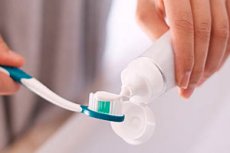New publications
Arginine Instead of Fluoride? Toothpaste with 8% Arginine Reduces Cavities in Children
Last reviewed: 18.08.2025

All iLive content is medically reviewed or fact checked to ensure as much factual accuracy as possible.
We have strict sourcing guidelines and only link to reputable media sites, academic research institutions and, whenever possible, medically peer reviewed studies. Note that the numbers in parentheses ([1], [2], etc.) are clickable links to these studies.
If you feel that any of our content is inaccurate, out-of-date, or otherwise questionable, please select it and press Ctrl + Enter.

The results of a two-year, double-blind, randomized study on 6,000 schoolchildren (10–14 years) were published in the journal JDR Clinical & Translational Research: toothpaste with 8% arginine reduced caries growth by 26% for DMFS and by 25% for DMFT compared with a control paste with 0.32% sodium fluoride. The formula with 1.5% arginine did not differ from the fluoride paste (equivalence).
Background
Why look for alternatives/supplements to fluoride at all?
Caries remains the most common non-communicable oral disease in adolescents worldwide, with a high burden in the 10-14 age group. Fluoride remains the “gold standard” for prevention, but some families and programs are looking for fluoride-free solutions (based on preference, availability, or individual indications) — hence the interest in assets that can reduce caries without fluoride.
Biology: Why Arginine?
Normally, some oral bacteria break down arginine via the arginine deiminase pathway (ADS) to form ammonia, which raises the pH of plaque and thus counteracts the decalcification of enamel/dentin by acid-producing microbes. Arginine acts as a “prebiotic” for arginolytic species and shifts the plaque ecosystem to a less cariogenic side.
What was known before the current RCT?
The evidence base for arginine has long been fragmented: an early systematic review (2016) found insufficient evidence to support adding arginine to toothpastes for caries prevention and called for large, independent RCTs. In parallel, data on combinations (e.g., arginine + fluoride/calcium) and microbiome studies have been accumulating, showing an increase in the proportion of arginolytic bacteria with the use of arginine-containing toothpastes. Recent reviews have already noted the anti-caries effect of formulas with 1.5% arginine + fluoride.
Why was a large study in schoolchildren needed?
Adolescents aged 10–14 are a high-risk group: behavior and hygiene are changing, sugars in the diet are increasing, and professional prevention is often underestimated. Therefore, testing fluoride-free arginine pastes in this cohort with “hard” endpoints (DMFS/DMFT) is critical to understand whether such formulas can become a real alternative or supplement to fluoride in public health.
What is fundamentally new in the current work?
A two-year, double-blind, multicenter RCT on 6,000 children
published in JDR Clinical & Translational Research directly compared two fluoride-free toothpastes with arginine (8% and 1.5%) against a control toothpaste with 0.32% NaF. Previously, there was no such scale and design specifically for fluoride-free arginine: the study demonstrates the superiority of 8% arginine over fluoride toothpaste in terms of caries growth and equivalence to the 1.5% formula, which closes a long-standing request for large, independent data.
Practical intrigue for the future
If the results are confirmed in other populations and settings, arginine pastes (especially 8%) could expand the prevention toolbox — from individual recommendations for families avoiding fluoride to public health programs in regions with a high caries burden. More research is needed on long-term safety, combination with fluoride/calcium, impact on the microbiome, and cost-effectiveness.
What did they do?
- Design: Phase III, double-blind, 3-parallel-group RCT; 2-year follow-up, 6- and 12-month follow-up.
- Groups: pastes with 8% arginine, 1.5% arginine and 0.32% NaF (positive control). Participants had ≥ 2 active carious lesions at baseline.
- Primary endpoints: DMFS and DMFT index increment at 24 months; non-inferiority margin analysis (0.2545).
Results
- 8% arginine vs NaF:
- DMFS: -26.0% (difference -0.16; 95% CI -0.22…-0.10; p <0.001).
- DMFT: -25.3% (difference -0.17; 95% CI -0.24…-0.11; p <0.001).
- 1.5% arginine vs NaF: no differences found (DMFS/DMFT equivalence).
- The authors' conclusion: depending on the concentration, arginine-containing pastes may be no worse or better than fluoride pastes in children with active caries.
Why is this important?
Fluoride is the gold standard for prevention, but some families seek fluoride-free alternatives (medical indications, personal preference). RCT data show that high concentrations of arginine (8%) can reduce caries growth more than a typical fluoride control formula, and 1.5% arginine provides protection equal to fluoride. This opens the way to expanding the arsenal of preventive tools in public health.
Important Disclaimers
- The study was conducted in China in children with existing caries; the generalizability of the results to other populations and oral care regimens requires testing.
- The effect depends on the concentration of arginine: 8% showed superiority, 1.5% - only equivalence to fluoride. The results should not be generalized to any "arginine pastes".
- Guidelines for caries prevention continue to rely on fluoride; updates to recommendations may be necessary following accumulation of independent evidence and assessment of long-term safety.
What does this mean in practice?
- For families who avoid fluoride for one reason or another, the 8% arginine option looks promising (discuss with your dentist).
- Regardless of the toothpaste, the key is regular brushing, limiting sugars and professional prevention.
Source: Yin, W., et al. (2025) Arginine Dentifrices and Childhood Caries Prevention: A Randomized Clinical Trial. JDR Clinical & Translational Research. doi.org/10.1177/23800844251361471.
